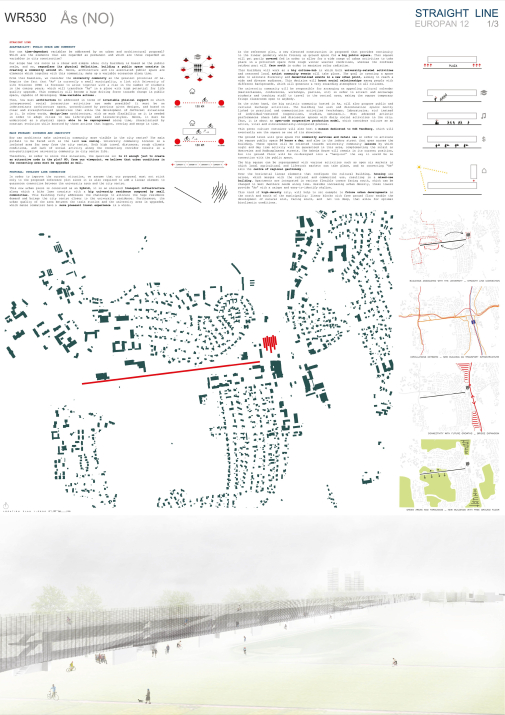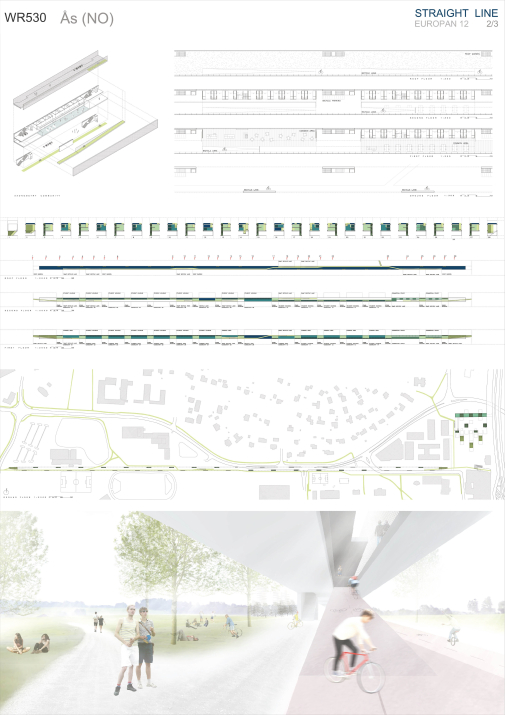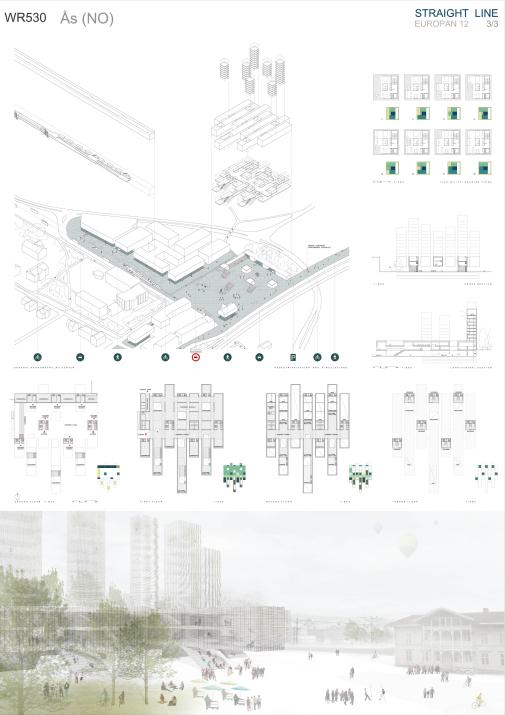Project:
Straight Line
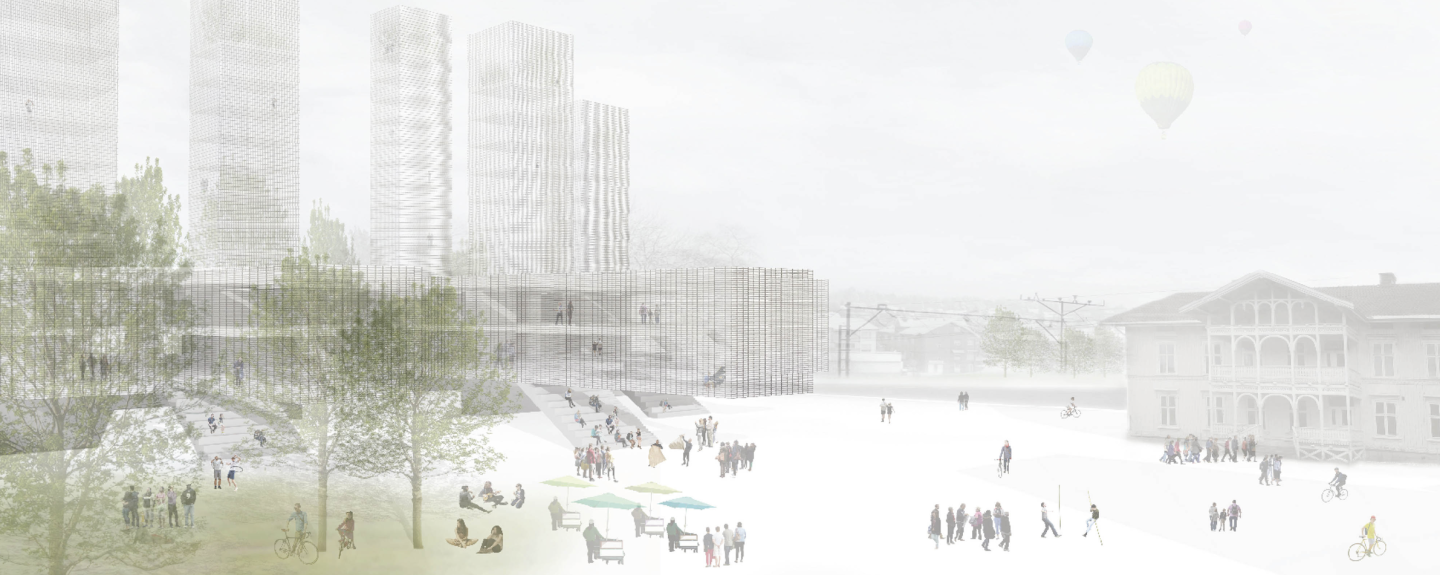
About
-
ADAPTABILITY:
PUBLIC SPACE AND COMMUNITYHow can time-dependant variables be addressed by an urban and architectural proposal? Which are the elements that are regarded as permanent and which are those regarded as variables in city construction?
Our scope has its roots in a clear and simple idea; city building is based on the public realm, and so, regardless its physical definition, building a public space consists in creating a community around it. Hence, architecture and its associated public space are elements which together with this community, make up a variable ecosystem along time.
From this baseline, we consider the university community as the greatest potential of As. Despite the fact that “As” is currently a small municipality, a link with University of Life Sciences (UMB) is foreseen to arise together with a rise in the number of students in the com- ing years, which will transform “As” in a place with high potential for life quality upgrade. This community will become a huge driving force towards change in public space, capable of developing time-variable actions.
Then, how must architecture be addressed in terms of invariable physical support on which interpersonal social interaction activities are made possible? It must be an indeterminate architecture space, unconditioned by previous given designs, and based on clear and straightforward geometries that allow the development of different situations in it. In other words, design-less architecture, with as much flexibility as it is needed in order to adapt cities to new life-styles and leisure-styles. Hence, it must be understood as a physical space able to be reprogrammed along time, character- ized by constant evolution while boosted by those actions that happen, overlay and merge in time.MAIN PROBLEM:
DISTANCE AND INACTIVITYHow can architects make university communi- ty more visible in the city centre? The main pitfall to be faced with is the land use zoning. Uni- versity community locates in a isolated area far away from the city centre. Both high travel distances, rough climate conditions, and lack of social activity along the connecting corridor results in a non-participative university community in city centre life.
Therefore, in order to solve this situation, the question is: Is it enough just to create an attractive node in the plot? NO, from our view- point, we believe that urban conditions in the connecting area must be upgraded as well.PROPOSAL: STRAIGHT LINE CONNECTION
In order to improve the current situation, we assume that our proposal must not stick only to the proposed reference plot since it is also required to add a linear element to guarantee connection between the university area and the city centre. This new urban piece is conceived as an hybrid, it is an elevated transport infrastructure along which a bike lane coexists with a big university residence composed by small communities. This building fully addresses the challenge to allocate the huge residence demand and brings the city centre closer to the university residence. Furthermore, the urban quality of the area between the train station and the university area is upgraded, which makes commuters have a more pleasant travel experience in a whole.In the reference plot, a new elevated construction is proposed that provides continuity to the linear geometry while freeing up ground space for a big public square. This square will get partly covered fed in order to allow for a wide range of urban activities to take place in a protected space from rough winter weather conditions, whereas the roofless outdoor part will face south in order to maximize solar radiation.
This building will work as a big culture-hub in which both university-related activities and renowned local artist community events will take place. The goal is creating a space able to allocate diversity and decentralized events in a new urban point, aiming to reach a wide and diverse audience. This decision will boost social relationships among people with different backgrounds, which will generate a very rewarding atmosphere to all citizens.
The university community will be responsible for arranging an appealing cultural calendar (masterclasses, conferences, workshops, parties, etc) in order to attract and encourage students and teaching staff to travel to the central area, making the square temporary fringe classrooms open to anybody.
On the other hand, the big artistic community hosted in As, will also propose public and cultural Exchange activities. The building has work and dissemination spaces mostly linked to practical and communication activities (workshops, laboratorios, etc) instead of individual-centered (expositions, studies, seminars...). Most advanced artistic performances share labs and discussion spaces with daily social activities in the city. Thus, it is about an open-code cooperative pro- duction model, which considers culture as an active, vital and einvironmentally- integrated process.
This great culture container will also host a museum dedicated to Odd Tandberg, which will eventually use the square as one of its showrooms.
The ground level will give space for community services and retail use in order to activate the square public space 24 hours a day, and also in the indoor street that goes across the building. These spaces will be oriented towards university com- munity leisure by which night and day time activity will be guaranteed in this area, complementing the retail in Moerveien and Radhusplassen streets. The Asheim House will remain in its current position, but its ground floor will be re-designed into a “hang-out” the way it would be in connection with the public space.The big square can be reprogrammed with various activities such as open air markets in which local agricultural and lifestock markets can take place, and so converting “As” into the centre of regional gastronomy.
Over the horizontal linear elements that configure the cultural building, housing use arises, which merges with the cultural and commercial use, resulting in a mixed-use building. Apartments are integrated in various flexible towers facing south, which can be changed to meet dwellers needs along time. Besides increas- ing urban density, these towers provide “As” with a unique and easy-to-identify skyline.
This kind of high-density city, will help to set example to future urban developments in the north and south of the municipality; linear blocks with free ground floor enable the development of natural soil, facing south, and not too deep, that allow for optimal bioclimatic conditions.
-
The project gives physical expression to a proposed strong linkage between the university and town by means of an elevated linear structural element composed of a hybrid urban program of student housing, cycle lane and public space. This singular linear element is envisaged as a series of linked communities, terminated towards a new mixed-use high-density city centre which is elevated above a big public square. The jury was impressed by the conceptual and provocative strength of the proposed linear structure which not only expresses connectivity between town and university but also articulate and frames the agricultural in-between landscape in one grand but ultimate playful, gesture. The jury is less convinced of the scale and configuration of the proposed high-density city centre. The original lightness of the proposed straight line here becomes overtly metropolitan and arguably too alien in relation to the actual site and its surrounding suburban context.
-
Simón Francés Martínez (ES)
Judith Sastre Arce (ES)Contact information:
www.francessastre.com
Related projects
-
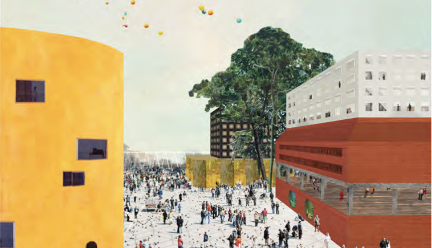
En, To, Tre...Rødt Lys!
Rather than being subjected to the volatile desires of the market, architecture can be used as…
-
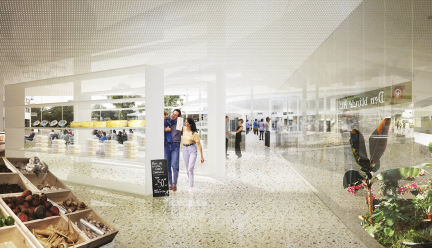
All eyes on Ås
The planning vision for Ås future cannot miss the call to integrate and interbreed the city life…
-

Straight Line
Our scope has its roots in a clear and simple idea; city building is based on the public realm, and…
